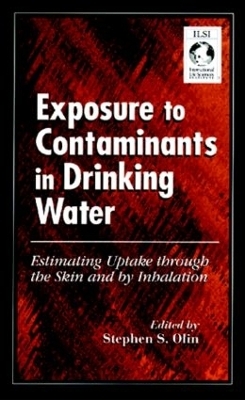
Exposure to Contaminants in Drinking Water
Crc Press Inc (Verlag)
978-0-8493-2804-6 (ISBN)
Exposure to Contaminants in Drinking Water: Estimating Uptake through the Skin and by Inhalation examines the current state of science in this field by identifying and reviewing the available information resources; evaluating various models and approaches; and demonstrating the feasibility of developing estimates of the distribution of absorbed doses of contaminants in drinking water through contact with the skin and by inhalation. This book, the product of a fifteen-member expert working group convened by the Risk Science Institute of the International Life Sciences Institute under a cooperative agreement with the U.S. Environmental Protection Agency's Office of Water, includes contributions from experts in exposure modeling and measurement; water chemistry; time-activity patterns; dermal and respiratory uptake; and the use of probability distributions in characterizing exposures.
Risk Science Institute International Life Sciences Institute Washington, D.C.
1 Introduction -- References -- 2 Contaminant Characteristics -- 2.1 Introduction -- 2.2 Physical and Chemical Parameters -- 2.3 The Contaminants -- 2.3.1 Inorganics -- 2.3.2 Organics -- References -- 3 Exposure Characteristics -- 3.1 Demographics -- 3.1.1 Relationship to Activity Patterns and to Building and Water Source Characteristics -- 3.1.2 Selecting a Basic Demographic Group -- 3.1.3 Applicable Census Data and Survey Results -- 3.1.4 Representation of National vs. Local Population Groups -- 3.1.5 Characterization of Sensitive Populations -- 3.1.6 Data Gaps and Research Needs -- 3.2 Consumption and Time /Activity Data -- 3.2.1 Principal Activities -- 3.2.2 Indirect (Second-Hand) Exposures -- 3.2.3 Variation among Population Groups -- 3.2.4 Applicable Databases -- 3.2.5 Ongoing Studies -- 3.2.6 Data Gaps and Research Needs -- 3.2.7 Primary References -- References -- 3.3 Building Characteristics -- 3.3.1 Residence Types and Subtypes, and Their Volumes -- 3.3.2 Air Exchange Rates -- 3.3.3 Airflow Between Rooms and Zones -- 3.3.4 Key Factors Affecting Degree of Air Exchange and Airflow -- 3.3.5 Applicable References and Databases -- 3.3.6 Data Gaps and Research Needs for Building Characteristics -- 3.3.7 Additional Publication -- References -- 3.4 Water Source Characteristics -- 3.4.1 Analysis of System Components -- 3.4.2 Estimation of Source Water Quality -- 3.4.3 Data Gaps and Research Needs -- References -- 4 Developing Exposure Estimates -- 4.1 Introduction /Overview -- 4.1.1 Ingestion Exposure -- 4.1.2 Inhalation Exposure -- 4.1.3 Dermal Absorption -- References -- 4.2 Transfer of Volatile Compounds from Drinking Water to Indoor Air -- 4.2.1 Introduction -- 4.2.2 Henry’s Law and the Mass-Transfer Coefficient -- 4.2.3 Predicting Mass-Transfer Rates -- 4.2.4 Measuring Mass-Transfer Coefficients -- 4.2.5 Relationship between KqLA, KoLa, and TE -- 4.2.6 Nonideal Conditions -- 4.2.7 Current State of Knowledge -- 4.2.8 Future Work -- References -- 4.3 Aerosols and Water Droplets -- 4.3.1 Definitions (Aerosols, Droplets) -- 4.3.2 Water Uses as Sources of Droplets /Aerosols -- 4.3.3 Lifetime of Droplets and Aerosols -- 4.3.4 Integration of Processes -- References -- 4.4 Water (Direct Contact) -- 4.4.1 Principles -- 4.4.2 Chemical Characteristics -- 4.4.3 Knowledge Gaps -- References -- 4.5 Modeling of Exposure to Waterborne Contaminants -- 4.5.1 Introduction -- 4.5.2 Modeling Methods -- 4.5.3 Representation of Input Parameters -- 4.5.4 Knowledge Gaps -- References -- 5 Respiratory Uptake -- 5.1 Introduction -- 5.2 Regions of the Respiratory Tract -- 5.3 Models for Assessing Respiratory Dosimetry -- 5.4 Sources of Airborne Drinking Water Toxicants -- 5.4.1 Volatile Gases -- 5.4.2 Aerosols -- 5.4.3 Other Sources -- 5.5 Physiologic and Pharmacokinetic Factors -- 5.5.1 Respiratory Parameters -- 5.5.2 Other Factors -- 5.6 Model Estimates of Lung Toxicant Uptake -- 5.6.1 The Contribution of Shower Aerosols to Uptake -- 5.6.2 Comparison of Inhalation and Dermal Uptake -- 5.7 Summary -- References -- 6 Dermal Uptake -- 6.1 Introduction -- 6.1.1 Exposure to Vapors -- 6.1.2 Exposure to Aerosols -- 6.1.3 Exposure to Liquid Water -- 6.2 Barrier Properties -- 6.2.1 Fick’sLaw -- 6.2.2 Skin Structure -- 6.2.3 Regional Variation -- 6.2.4 Effect of Skin Damage -- 6.2.5 Effect of Temperature and Blood Flow Rate -- 6.2.6 Effect of Hydration -- 6.2.7 Effect of Soaps and Surfactants -- 6.2.8 Effect of Ionization -- 6.2.9 Consideration of Special Populations -- 6.2.10 Summary -- 6.3 Types of Skin Penetration Data -- 6.3.1 Ways to Express Penetration -- 6.3.2 Experimental Methods -- 6.3.3 Sources of Penetration Data -- 6.3.4 Correlations from Many Data Sets -- 6.4 Mathematical Models of Penetration -- 6.4.1 Membrane Models -- 6.4.2 Pharmacokinetic Models -- 6.5 Recommendations of Experimental Methods -- for Water Exposures -- 6.6 Recommendations for Use of Penetration Data -- for Risk Assessments -- References -- 7 Case Study -- 7.1 Introduction -- 7.2 Modeled Residence -- 7.3 Activity Patterns -- 7.4 Water Uses -- 7.4.1 Simulating Water Use Occurrences -- 7.4.2 Simulating Water Use Durations -- 7.4.3 Humidifier Water Uses -- 7.5 Modeling Contaminant Emissions During Household Water Uses -- 7.5.1 Volatilization Models -- 7.5.2 Model Inputs for Water-Using Devices -- 7.5.3 Aerosol Emissions -- 7.6 Modeling Absorbed Dose -- 7.6.1 Absorbed Dose due to Vapors -- 7.6.2 Absorbed Dose due to Aerosols -- 7.6.3 Absorbed Dose due to Dermal Contact -- 7.7 Results -- 7.7.1 Results of a Selected Case -- 7.7.2 Results of Population Dose Distribution -- 7.7.3 Discussion -- 7.8 Conclusions -- References -- Index.
| Erscheint lt. Verlag | 19.11.1998 |
|---|---|
| Zusatzinfo | 40 Tables, black and white |
| Verlagsort | Bosa Roca |
| Sprache | englisch |
| Maße | 156 x 234 mm |
| Gewicht | 620 g |
| Themenwelt | Naturwissenschaften ► Biologie ► Biochemie |
| Naturwissenschaften ► Biologie ► Ökologie / Naturschutz | |
| ISBN-10 | 0-8493-2804-7 / 0849328047 |
| ISBN-13 | 978-0-8493-2804-6 / 9780849328046 |
| Zustand | Neuware |
| Informationen gemäß Produktsicherheitsverordnung (GPSR) | |
| Haben Sie eine Frage zum Produkt? |
aus dem Bereich


